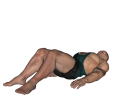 Glute - Ankle On The Knee Stretch
Glute - Ankle On The Knee Stretch
Benefits: This is a good exercise for core glute muscle development.
Purpose: This exercise is a controlled, balanced glute exercise for building tone and shape.
Beginner Glutes Stretching Body Only Gym Home
General Info: The glutes consist of the gluteus maximus, gluteus medius, and gluteus minimus. They create hip joint motion to lift the thigh forward, lift the thigh to the side, rotate the leg inward, and rotate the thigh outward.
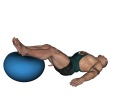 Glute - Fitness Ball Raise
Glute - Fitness Ball Raise
Benefits: This is a good exercise for core glute muscle development.
Purpose: This exercise is a controlled, balanced glute exercise for building tone and shape.
Beginner Glutes Hamstrings Abdominals Stretching Fitness Ball Gym
General Info: The glutes consist of the gluteus maximus, gluteus medius, and gluteus minimus. They create hip joint motion to lift the thigh forward, lift the thigh to the side, rotate the leg inward, and rotate the thigh outward.
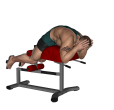 Glute - Ham Raise
Glute - Ham Raise
Benefits: This exercise is one of the best movements for the posterior chain - lower back, glutes, hamstrings and calves. It trains your hamstrings a both hip and knee, unlike the leg curl.
Purpose: This exercise works the hamstrings, plus other muscles in the posterior chain.
Intermediate Hamstrings Glutes Lower Back Calves Strength Glute Ham Raise Machine Compound Gym
General Info: The Hamstrings is a group of muscles responsible for flexing the knee. Some members of the hamstring group also straighten the hip. Sometimes the term -leg biceps- is used instead of hamstrings but the leg biceps is actually part of the hamstring group.
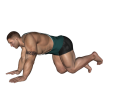 Glute - Kickback
Glute - Kickback
Benefits: This is a good exercise for core glute muscle development.
Purpose: This exercise is a controlled, balanced glute exercise for building tone and shape.
Beginner Glutes Hamstrings Strength Body Only Push Compound Gym Home
General Info: The glutes consist of the gluteus maximus, gluteus medius, and gluteus minimus. They create hip joint motion to lift the thigh forward, lift the thigh to the side, rotate the leg inward, and rotate the thigh outward.
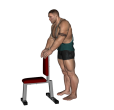 Glute - Leg Lift
Glute - Leg Lift
Benefits: This is a good exercise for core glute muscle development.
Purpose: This exercise is a controlled, balanced glute exercise for building tone and shape.
Intermediate Glutes Hamstrings Strength High Low Cable Machine Pull Compound Gym
General Info: The glutes consist of the gluteus maximus, gluteus medius, and gluteus minimus. They create hip joint motion to lift the thigh forward, lift the thigh to the side, rotate the leg inward, and rotate the thigh outward.
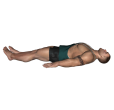 Glute - Raise
Glute - Raise
Benefits: This is a good exercise for core glute muscle development.
Purpose: This exercise is a controlled, balanced glute exercise for building tone and shape.
Beginner Glutes Hamstrings Abdominals Stretching Body Only Gym Home
General Info: The glutes consist of the gluteus maximus, gluteus medius, and gluteus minimus. They create hip joint motion to lift the thigh forward, lift the thigh to the side, rotate the leg inward, and rotate the thigh outward.
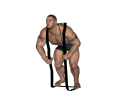 Good Morning - Band
Good Morning - Band
Benefits: This exercise has a different resistance curve from back extensions so these two exercises make a good combination.
Purpose: This exercise can be a powerful tool for developing the spinal erectors.
Intermediate Lower Back Hamstrings Glutes Strength Band Pull Compound Gym
General Info: The muscles of the lower back straighten the spine. They work together with the abdominals to keep the spine upright. Good Mornings places a lot of stress on the lower back.
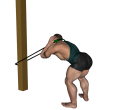 Good Morning - Band Pull Through
Good Morning - Band Pull Through
Benefits: This exercise has a different resistance curve from back extensions so these two exercises make a good combination.
Purpose: This exercise can be a powerful tool for developing the spinal erectors.
Intermediate Lower Back Hamstrings Glutes Strength Band Pull Compound Gym
General Info: The muscles of the lower back straighten the spine. They work together with the abdominals to keep the spine upright. Good Mornings places a lot of stress on the lower back.
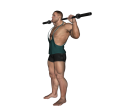 Good Morning - Basic
Good Morning - Basic
Benefits: This exercise has a different resistance curve from back extensions so these two exercises make a good combination.
Purpose: This exercise can be a powerful tool for developing the spinal erectors.
Intermediate Lower Back Hamstrings Glutes Strength Barbell Push Compound Gym
General Info: The muscles of the lower back straighten the spine. They work together with the abdominals to keep the spine upright. Good Mornings places a lot of stress on the lower back.
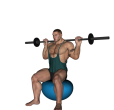 Good Morning - Fitness Ball Barbell
Good Morning - Fitness Ball Barbell
Benefits: This exercise has a different resistance curve from back extensions so these two exercises make a good combination.
Purpose: This exercise can be a powerful tool for developing the spinal erectors.
Intermediate Lower Back Hamstrings Glutes Strength Barbell Fitness Ball Push Compound Gym
General Info: The muscles of the lower back straighten the spine. They work together with the abdominals to keep the spine upright. Good Mornings places a lot of stress on the lower back.
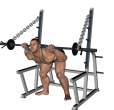 Good Morning - Hanging Bar
Good Morning - Hanging Bar
Benefits: This exercise has a different resistance curve from back extensions so these two exercises make a good combination.
Purpose: This exercise can be a powerful tool for developing the spinal erectors.
Intermediate Lower Back Hamstrings Glutes Strength Barbell Power Rack Chains Push Compound Gym
General Info: The muscles of the lower back straighten the spine. They work together with the abdominals to keep the spine upright. Good Mornings places a lot of stress on the lower back.
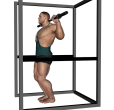 Good Morning - Off Pins
Good Morning - Off Pins
Benefits: This exercise has a different resistance curve from back extensions so these two exercises make a good combination.
Purpose: This exercise can be a powerful tool for developing the spinal erectors.
Intermediate Lower Back Hamstrings Glutes Strength Barbell Smith Machine Push Compound Gym
General Info: The muscles of the lower back straighten the spine. They work together with the abdominals to keep the spine upright. Good Mornings places a lot of stress on the lower back.
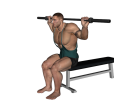 Good Morning - Seated
Good Morning - Seated
Benefits: This exercise has a different resistance curve from back extensions so these two exercises make a good combination.
Purpose: This exercise can be a powerful tool for developing the spinal erectors.
Intermediate Lower Back Hamstrings Glutes Strength Barbell Flat Bench Push Compound Gym
General Info: The muscles of the lower back straighten the spine. They work together with the abdominals to keep the spine upright. Good Mornings places a lot of stress on the lower back.
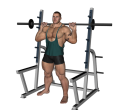 Good Morning - Straight Leg Barbell
Good Morning - Straight Leg Barbell
Benefits: This exercise has a different resistance curve from back extensions so these two exercises make a good combination.
Purpose: This exercise can be a powerful tool for developing the spinal erectors.
Intermediate Lower Back Hamstrings Glutes Strength Barbell Squat Rack Push Compound Gym
General Info: The muscles of the lower back straighten the spine. They work together with the abdominals to keep the spine upright. Good Mornings places a lot of stress on the lower back.
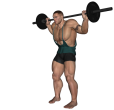 Good Morning - Variation
Good Morning - Variation
Benefits: This exercise has a different resistance curve from back extensions so these two exercises make a good combination.
Purpose: This exercise can be a powerful tool for developing the spinal erectors.
Intermediate Lower Back Hamstrings Glutes Strength Barbell Push Compound Gym
General Info: The muscles of the lower back straighten the spine. They work together with the abdominals to keep the spine upright. Good Mornings places a lot of stress on the lower back.
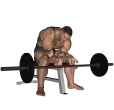 Grip Work - Basic
Grip Work - Basic
Benefits: This exercise focuses on the finger flexors with the forearms supinated.
Purpose: This exercise strengthens the muscles that flex the fingers.
Beginner Forearms Strength Barbell Pull Gym
General Info: A complete forearm program must achieve balanced development for all major forearm muscles. The forearm is involved in six different forearm movements. They include wrist flexion, wrist extension, wrist abduction, wrist adduction, forearm pronation, and forearm supination. There are additional muscles found in the forearm that are involved in movements like elbow flexion (brachioradialis), finger flexion, and finger extension.
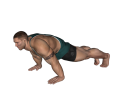 Groiners - Basic
Groiners - Basic
Benefits: This is a good exercise for strengthening the muscles for raising the legs to the sides.
Purpose: This exercise is a controlled, balanced inner hip exercise for abducting the hip.
Intermediate Hip Adductors Hip Abductors Strength Body Only Pull Gym Home
General Info: There are four groups of muscles that cause movement in the hip joint. They include the gluteal group, the lateral rotator group, the adductor group, and the iliopsoas group. The prime group for hip adduction is, obviously, the adductor group, a group of muscles on the inner hip joint.
Could not find your favorite exercise in the list? Please start a discussion and post the name and the list of steps. We will try to add it as soon as we can.